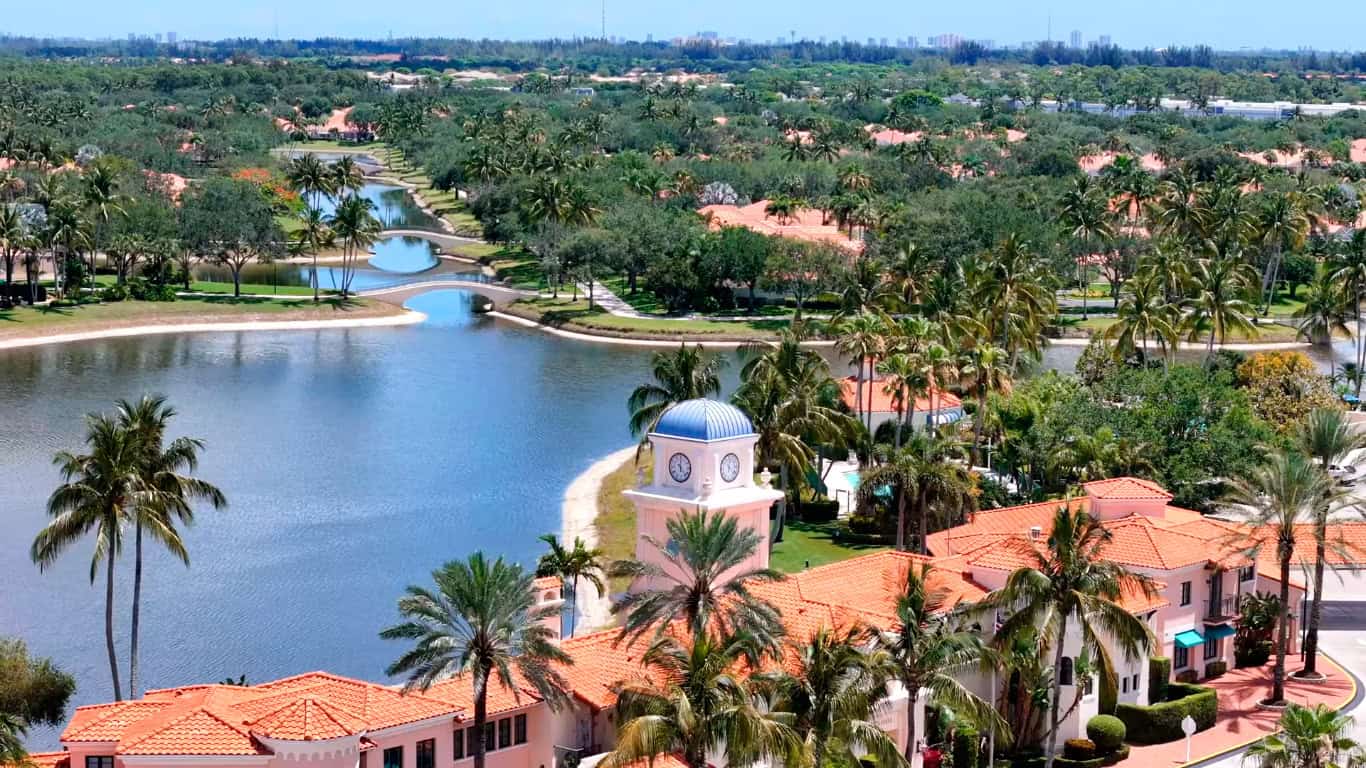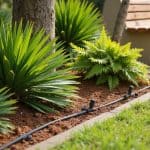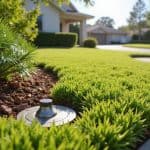Managing HOA landscaping in West Palm Beach brings unique challenges. Property managers must balance strict rules with Florida’s harsh climate. Many communities struggle to keep their grounds looking fresh while following HOA guidelines and saving water.
Smart landscape planning makes a huge difference in West Palm Beach HOAs. Modern irrigation systems can cut water use by 50% through proper scheduling and maintenance. Our guide covers the essential HOA landscaping best practices in West Palm Beach.
We share proven tips for plant selection, water conservation, and regular upkeep that boost curb appeal and property values. Ready to transform your HOA landscape?
Key Takeaways
- West Palm Beach HOAs require 60% native Florida plants in new installations and grass heights under 7 inches, with fines starting at $100 per day for violations.
- Smart irrigation systems can reduce water usage by 30-50% through rain sensors, drip systems, and proper scheduling during early morning or late evening hours.
- Properties must maintain at least 25% green space, remove dead plants within 14 days, and install new plants within 30 days to meet HOA rules.
- Business owners need permits costing $150-$500 plus HOA approval before making landscape changes, while following the Preferred Species List for plant selection.
- Regular maintenance includes proper mulching, weed control, tree pruning, and debris removal to protect property values and create positive first impressions for visitors.
Key HOA Landscaping Guidelines in West Palm Beach
HOA landscaping guidelines shape the visual appeal and property values in West Palm Beach communities. These rules create clear standards for lawn care, plant choices, and maintenance schedules that every property owner must follow.
Lawn and turf maintenance standards
Proper lawn maintenance forms the backbone of commercial property care in West Palm Beach. Local rules require grass heights under 7 inches, with strict mowing schedules to keep properties looking sharp.
Property managers must follow zero-tolerance weed policies and maintain at least 25% green space on their lots. These standards protect property values and create a professional image for businesses.
Regular mowing, fertilization, and irrigation create healthy turf that meets HOA requirements in Palm Beach County. Dead plants need quick removal within 14 days, plus new plantings within 30 days to stay compliant.
Missing these rules leads to daily fines of $100 or more from both the city and homeowners’ associations. Smart lawn care helps businesses avoid penalties while building strong curb appeal that attracts customers.
Approved plant and tree lists
Plant selection rules in West Palm Beach HOAs follow strict guidelines from the Palm Beach County Zoning Division. The Preferred Species List serves as a guide for commercial landscaping projects, making plant choices easier and compliant.
- Native Florida plants must make up 60% of new installations in HOA landscapes to meet local rules and boost curb appeal.
- Palm trees rank high on the approved list due to their salt tolerance and suitability for zones 9b to 10b in Florida.
- Drought-resistant shrubs earn spots on the approved list because they need less water and maintenance.
- Ground covers from the Interactive Plant Material Database offer proven choices for filling garden spaces.
- Salt-tolerant plants get special marking in three levels: Low, Medium, and High resistance to coastal conditions.
- Light requirement labels help match plants to specific areas, from Full Sun to Shade options.
- Tree species come with details about growth patterns, flowering times, and needed care.
- The database updates regularly to remove prohibited species and add new approved options.
- Florida-native species get priority status because they adapt well to local weather patterns.
- Commercial property managers must check the current approved list before starting new landscape projects.
- Plants with high water needs face restrictions due to water conservation efforts.
- Garden designs must include a mix of approved trees, palms, shrubs, and ground covers.
- Smart irrigation systems pair well with approved plants to create water-efficient landscapes.
- Plant spacing follows set guidelines to prevent overcrowding as gardens mature.
Edging and weed control requirements
HOA standards demand sharp lawn edges and zero weeds in all landscaped areas. Professional edging creates clean lines between grass and hardscapes, giving properties that crisp, well-maintained look.
Strict rules require regular weed removal from both lawns and flower beds through proper mulching and targeted herbicide applications. Commercial landscapers must perform routine inspections to catch any weed growth early.
Proper groundcover maintenance includes fresh mulch layers to stop weed seeds from sprouting. Smart edging practices help define clear boundaries between different landscape zones while supporting effective weed control.
HOAs conduct frequent checks to ensure properties meet these essential standards. Failed inspections can lead to fines or mandatory landscape restoration work. Regular seasonal care keeps weeds under control and maintains those clean, defined edges that HOA communities expect.
Best Practices for Plant Selection
Smart plant selection forms the backbone of successful HOA landscaping in West Palm Beach. Your property needs plants that match Florida’s climate while meeting strict HOA rules for a beautiful and lasting landscape.
Use of drought-resistant plants
Drought-resistant plants offer a smart solution for commercial properties in West Palm Beach. These hardy species thrive in South Florida’s climate while cutting water costs for businesses.
The Unified Land Development Code promotes these plants as a key part of sustainable landscaping practices. Many native Florida species need less water and maintenance, which leads to lower operating expenses.
Property managers can choose from the Preferred Species List to create beautiful, low-water landscapes. These plants handle dry spells better than traditional options and help meet rising water restrictions.
The initial investment in drought-resistant landscaping pays off through reduced water bills and maintenance needs. Local HOAs now push for water-wise plant choices to protect property values during frequent drought conditions.
Incorporating native Florida species
Native Florida plants create strong roots in HOA landscaping projects. Palm Beach County rules require 60% of new plants to be native species. These plants reduce energy costs and cut down pollution levels.
Smart property managers choose plants from the Preferred Species List for trees, palms, shrubs, and ground covers. The Interactive Plant Material Database helps businesses pick the right native plants for their needs.
Native plants match perfectly with Florida’s natural environment. They need less water and care than non-native options. The AGR and Glades Tiers demand more native plants in big open spaces.
This rule helps save water and creates natural spaces that last. Property values rise with well-planned native landscaping. Local rules say businesses must remove banned non-native plants to stay within HOA guidelines.
Efficient Irrigation Strategies
Smart irrigation systems save water and money through precise water delivery to plants. Modern drip systems and rain sensors help HOA communities maintain lush landscapes while meeting strict water conservation rules.
Installation of smart irrigation systems
Modern irrigation systems save money through smart water management. These systems use rain sensors to stop watering during rainfall and high-efficiency sprinkler heads to reduce waste.
Property managers can divide their grounds into specific zones with specialized valves. This setup allows different areas to receive the right amount of water based on plant needs.
Professional installation ensures your system meets HOA standards in West Palm Beach. The initial cost pays off through lower monthly water bills within a few years. Direct water delivery to plant roots through drip irrigation cuts waste and promotes healthy growth.
The system’s smart controllers adjust watering schedules based on weather changes and soil moisture levels, creating an efficient landscape maintenance program.
Water conservation techniques
Smart water management helps businesses save money and protect the environment. HOA communities can reduce water usage by 30 to 50 percent through proper conservation methods.
- Install water meters to track actual usage and spot leaks fast. These devices show real water consumption patterns in your landscaping.
- Set up drip irrigation systems that deliver water straight to plant roots. This method stops water waste through evaporation or runoff.
- Use smart irrigation controllers that adjust watering schedules based on weather data. These systems prevent overwatering during rainy periods.
- Schedule irrigation during early morning or late evening hours to cut down water loss. This timing leads to better water absorption by plants.
- Place mulch around plants and trees to retain soil moisture. A 2-3 inch layer helps reduce evaporation and keeps roots cool.
- Fix broken sprinkler heads and leaky pipes right away. Regular system checks stop water waste and prevent damage to landscaping.
- Group plants with similar water needs together in zones. This practice makes irrigation more efficient across the property.
- Install rain sensors to shut off sprinklers during wet weather. These devices prevent unnecessary watering and protect local waterways.
- Monitor soil moisture levels before watering. Simple moisture meters help avoid overwatering and root problems.
- Adjust sprinkler heads to spray only on plants, not sidewalks or buildings. Proper alignment saves water and money on utility bills.
Regular Maintenance Practices
Regular yard care makes a huge difference in HOA communities. Professional landscaping teams handle essential tasks like tree pruning, weed removal, and mulch application to keep properties in top shape.
Pruning and trimming trees and shrubs
Professional tree pruning creates strong, healthy plants and boosts curb appeal for HOA communities. Sharp, clean tools must cut branches at the right spots to shape growth patterns.
Certified arborists inspect trees often to spot unsafe conditions and guide proper pruning methods. Trees need training while young to grow a single main trunk and sturdy branches.
Smart pruning techniques like thinning and heading give different looks and structures to plants. Spring-flowering shrubs require pruning right after blooms fade for the best results.
Proper tree selection from the start cuts down early pruning needs and prevents future problems. The right timing and tools help avoid plant diseases and encourage vigorous growth in West Palm Beach landscapes.
Fertilization and mulching
Proper fertilization and mulching create healthy landscapes in West Palm Beach HOA communities. Smart fertilizer choices must follow strict HOA rules, especially near water areas. Slow-release nitrogen fertilizers reduce environmental impact while feeding plants steadily.
Regular applications support vibrant colors and strong growth across turf, trees, and flower beds.
Mulch plays a vital role in HOA-approved landscape designs. The right mulch depth helps save water, blocks weeds, and keeps soil at good temperatures. HOA guidelines require consistent mulch types throughout properties to maintain a polished look.
This practice leads to better curb appeal and higher property values in Florida landscaping projects.
Managing debris and weed control
Regular debris removal stands as a critical HOA requirement for landscape maintenance in West Palm Beach. Property managers must clear fallen leaves, branches, and other yard waste to maintain clean, safe grounds.
Dead plants need removal within 14 days, with new plantings installed within 30 days to meet strict HOA standards.
Weed control demands constant attention through planned maintenance schedules in HOA communities. Visible weeds can trigger monetary fines or required fixes from the HOA board. Smart weed management keeps lawns healthy and stops unwanted plant spread.
Commercial landscaping teams follow set schedules for debris pickup and weed treatments to protect property values. Yard tools and waste bins must stay hidden from view to keep neighborhood looks neat.
The Importance of Commercial Landscaping Maintenance
Commercial landscaping maintenance plays a vital role in business success throughout West Palm Beach. Smart property owners know that well-kept grounds create positive first impressions and boost business appeal.
A complete landscape care plan must include proper lawn care, tree pruning, and hardscape upkeep. These elements help maintain safety standards while lifting curb appeal for visitors and clients.
Professional landscape maintenance guards property values and meets strict HOA rules in Palm Beach. Business owners need permits ranging from $150 to $500 for landscape changes, plus HOA approval before starting work.
Local codes require grass heights under 7 inches and at least 25% green space on commercial lots. Smart irrigation systems and water conservation methods cut costs while keeping grounds looking fresh.
Proper tree trimming and weed control create a healthier environment that attracts more customers to the property.
Compliance with Local HOA and Municipal Regulations
Local rules require Palm Beach County properties to keep 25% green space and grass under 7 inches tall. Business owners must get permits ($150-$500) and HOA approval before making any landscape changes.
The Unified Land Development Code sets clear standards for landscape design, plant choices, and upkeep in West Palm Beach. Dead plants need quick removal within 14 days, with new plants going in within 30 days to stay within rules.
Property managers face strict HOA landscaping standards, with fines starting at $100 per day for breaking the rules. Professional property management teams help track these rules through regular checks.
The law states that 60% of new plants must be Florida native species. Smart business owners partner with expert landscaping teams to meet these strict HOA and city requirements, keeping their properties beautiful and legal.
Conclusion
Proper HOA landscaping practices create stunning West Palm Beach communities. Smart irrigation systems paired with native Florida plants build sustainable, beautiful spaces. Regular maintenance keeps properties pristine while meeting strict HOA standards.
Professional landscaping services help communities stay compliant and boost property values through expert care and management.
FAQs
1. What are the basic HOA landscaping rules in West Palm Beach?
HOA communities in West Palm Beach require regular lawn care, tree pruning, and weed control. Property management teams must maintain curb appeal through proper landscape design and irrigation systems.
2. How often should trees and hedges be pruned in Florida landscaping?
Trees need trimming every 6 months, while hedges should be pruned monthly to protect architectural features and maintain property values.
3. What water conservation methods work best for HOA landscapes?
Smart sprinkler systems and native plants help in conserving water during water shortages. The proper setup of irrigation systems saves water resources and money on utility bills.
4. Can homeowners plant vegetable gardens in their front yard?
Most homeowners associations require submittals and approval before starting vegetable gardens. The rules vary between communities in the greater Orlando area and Orange County.
5. What type of return on investment can proper landscaping maintenance provide?
Good landscaping maintenance can increase property values by 15% and boost curb appeal significantly.
6. Which native plants work best for Florida HOA landscapes?
Florida-friendly plants like muhly grass, coontie, and saw palmetto thrive in local conditions and need less water than non-native species.




